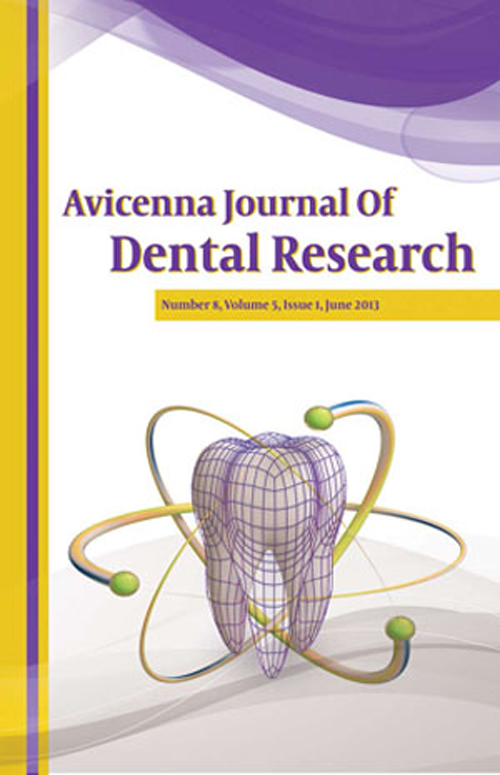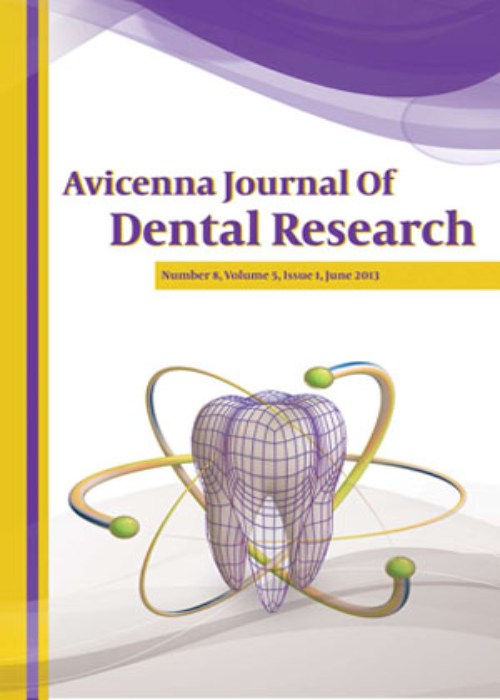فهرست مطالب

Avicenna Journal of Dental Research
Volume:10 Issue: 3, Sep 2018
- تاریخ انتشار: 1397/06/17
- تعداد عناوین: 7
-
-
Pages 71-76BackgroundPermanent tooth impaction is a relatively common abnormality in which early treatment can prevent from other developmental disorders. Maxillary central impaction can occur because of mesiodens, dilacerations, trauma to deciduous tooth and space deficiency. Prevalence of maxillary central impaction is 0.06%-2.0%.MethodsIn this retrospective, case-control study, 28 people with impacted maxillary central incisor and 56 as the control group were studied. All participants were 8-12 years old. The data were collected from private offices of orthodontists and special pediatric dentists and Hamadan dental school. The data required were diagnostic models, initial panoramic radiography and initial lateral cephalometry radiography. Data analysis was done by SPSS software using t test and chi-square test.ResultsThe most common causes of maxillary central impaction were: mesiodens (74.4%), dilacerations (14.3%), space deficiency (10.7%) and cyst (3.6%). 89.3% of cases had unilateral maxillary central impaction and 10.7% had bilateral maxillary central impaction. There was a significant relation between skeletal class II and maxillary central impaction. ANB angle was significantly higher in impaction group than in control group (P<0.05). In most of the patients with maxillary central impaction, ipsilateral canines had upper position compared with the contralateral side (60%).ConclusionsPresence of mesiodens was the most important reason for maxillary central incisor impaction, and class II jaw relation is more common in patients with maxillary central incisor impaction, which higher incidence of vertical disorders can be a bigger challenge in these patients.Keywords: Maxillary central incisor, Impaction, Dentoskeletal characteristics, Maxilla
-
Pages 77-82BackgroundTeeth bruxism and clenching are important parafunctional habits that have a high prevalence and can cause serious physical and mental complications. Its etiology, however, remains a challenging issue. Therefore, the present study was conducted to investigate the relationship between occlusal parameters and bruxism in 3- to 6-year-old children.MethodsThis study was conducted in a 3- to 6-year-old preschool children in Hamadan selected by random sampling. To do this, a questionnaire containing 6 standard and comprehensive questions was completed by parents. According to the data from the questionnaires, the children were divided into bruxers and nonbruxers (control). In the intra-oral clinical examination, the presence of facet, cross bite in the anterior or posterior, excessive overjet, open bite, deep bite and the type of dental occlusion on both sides were recorded. The statistical tests used were Spearman correlation coefficient and chisquared test in SPSS 23.ResultsThe findings showed that the prevalence of bruxism was 72% in the studied population. The most observable occlusions were flash terminal and mesial step on both sides. There was no significant relationship between bruxism and dental facet and the correlation of age and sex with bruxism was weak. There was no statistically significant relationship between the occlusal parameters, except for overbite, and bruxism.ConclusionsThe results showed that among occlusal factors, only normal overbite and openbite were significantly associated with bruxism.Keywords: Bruxism, Occlusal factors, Preschoolers
-
Pages 83-88BackgroundThe prevalence of periodontal diseases in patients with type 2 diabetes and improper glucose control is significantly higher. The aim of this study is to investigate the effect of scaling and root planning and chlorhexidine digluconate rinse on metabolic control in type 2 diabetic patients.MethodsA total of 60 patients with poorly controlled type 2 diabetes and moderate chronic periodontitis were selected, and randomly divided into three groups. We performed scaling and root planning in 2 test groups (T1, T2), with 0.2% chlorhexidine rinse used only for test group 2. Follow-up including one evaluation 3 months later and a visit 6 months later, was to evaluate glycemic control (FBS and HbA1c) and periodontal status (PI and CPI). Data were presented as mean ± standard deviation (SD) and analyzed using Student’s t test and Wilcoxon test in SPSS 20.0.ResultsThe mean changes in all variables in both test groups except FBS were significantly reduced (P<0.01). T2 group showed better results at 3-month evaluation.ConclusionsNon-surgical periodontal therapy improves periodontal health indicators and metabolic control in type 2 diabetic patients. Chlorhexidine is more effective on periodontal status and metabolic control in the short term.Keywords: Chlorhexidine, Diabetes mellitus, Periodontitis
-
Pages 89-94BackgroundOral cancers are the 11th leading cancers worldwide, with an annual mortality rate of 500 across the world. Therefore, the aim of the present study was to evaluate the awareness of dental students about prevention, early diagnosis and referral of patients with oral cancers in Tabriz Azad University in 2018.MethodsThe present descriptive, cross-sectional study was carried out in 2018 in dental students from the third to the sixth year of their studies in Tabriz Azad University using their self-reports. To this end, 153 dental students were randomly selected based on their education levels and included in the study. Data were collected using a standard questionnaire and analyzed by chi-squared test. Statistical significance was considered to be P<0.05.ResultsA total of 80.4% of the students examined the oral mucosa during routine clinical examinations and 83.7% reported that they would warn their patients about the risk factors for cancers after graduation. Only 51% of the students had ever had a chance to examine patients with oral lesions. A total of 67.1% of the subjects reported that they did not have adequate awareness of prevention of oral cancers and 91.5% were interested in gaining more knowledge about oral cancers. When the subjects were questioned about knowledge about the clinical manifestations of oral cancers, 31.4% exhibited very low level of knowledge. The majority of students (78.5%) believed that an ulcer with irregular margins that lasted for more than two weeks was due to cancer.ConclusionsThe results showed a moderate level of knowledge in dental students about the clinical manifestations of oral cancers, the related risk factors and how to refer patients with such cancers. The majority of the students reported inadequate information and knowledge about prevention of oral cancers and needed to gain more knowledge.Keywords: Awareness, Dental students, Oral cancers, Prevention
-
Pages 95-100BackgroundAt present, most patients have wrong perceptions and attitudes toward dental scaling; therefore, they hesitate receiving it. This study aimed to assess the knowledge, attitude and practice of patients attending to dental clinics in Isfahan with regard to dental scaling.MethodsThis descriptive, cross-sectional study was conducted in 200 patients referring to dental clinics in Isfahan in 2016. Sampling was sequential and randomized. A researcher-designed questionnaire was used to collect data, which covered demographic information, knowledge, attitude and practice of patients regarding scaling.ResultsThe knowledge and practice scores had a significant correlation with education level. In addition, the knowledge and attitude scores had a significant correlation with age and positive history of scaling and root planning (SRP) (P<0.05).ConclusionsThe results showed that most patients had moderate or good knowledge about scaling while the majority of them had a neutral attitude toward it and more than half had moderate practice in this respect. Thus, knowledge promotion should be performed in a way that attitude and practice are significantly influenced. This calls for strategic planning by the Ministry of Health and cooperation of the media and enforcement organizations affiliated to the Ministry of Health.Keywords: Dental scaling, Knowledge, Attitude
-
Pages 101-106BackgroundSodium hypochlorite and EDTA solutions are used in the preparation of dentin surfaces, which may increase the bond strength of the composite restorations and decrease their microleakage scores. This in-vitro experimental study aimed to assess the effect of dentin surface conditioning with EDTA/trypsin solution prior to bonding procedure with Clearfil S3 Bond on the microleakage of class V composite restorations.MethodsClass V cavities were prepared on the buccal and lingual surfaces of 18 human premolars (n=18) and randomly assigned into two groups. In the control group, Clearfil S3 Bond was applied on the dentin surfaces. While in the experimental group, before applying Clearfil S3 Bond, the surfaces were conditioned with EDTA/trypsin solution. The cavities on the teeth were then incrementally filled with Filtek Z250 light-cure composite. Afterward, all the samples were thermocycled for 500 cycles. Next, the specimens were immersed in methylene blue solution for 72 hours. The restorations were sectioned buccolingually through the center of the restorations with a diamond disk. Then, microleakage at the tooth- restoration interface was evaluated in the enamel and dentin margins blindly using dye penetration under a stereomicroscope at ×40 magnification. Finally, data were statistically analyzed by Mann-Whitney U test.ResultsThe results showed no significant differences between two groups regarding the microleakage scores of the enamel and dentin edges. In addition, in all sections and edges of the experimental group, decreased microleakage scores were attained compared to the control specimens (P<0.03).ConclusionsRegarding the limitations of the present study, the preparation of dentin surfaces with EDTA/trypsin solution before applying Clearfil S3 Bond resulted in the decreased microleakage scores compared to unprepared surfaces.Keywords: EDTA, Microleakage, One-stage bonding system, Trypsin solution
-
Pages 107-113BackgroundThis study was conducted to compare the microshear bond strength (MSBS) of chemicallycured and light cured composite to resin-modified glass-ionomer (RMGI) based on different types of adhesive systems.MethodsThirty-two discs of Vitrebond RMGI were prepared and randomly divided into 8 groups. Four cylinders of composite resin were placed on each RMGI sample. Z250 composite was bonded to the RMGI discs with Single-Bond, Clearfil SE-Bond, and Clearfil S3-Bond adhesive agent in groups 1, 2 and 3, respectively. Group 4 was considered to be the control group without any adhesive. In groups 5-8, the procedures were the same as those in groups 1-4, except that a chemically-cured composite (Master Dent) was used. All the samples were kept at 37˚C for 24 hours and tested for MSBS by a mechanical testing machine at a strain rate of 0.5 mm/min. Failure mode was assessed under a stereomicroscope. Data analysis was carried out by two-way ANOVA, independent t test, one-way ANOVA and Tukey honestly significant difference test.ResultsApplication of a bonding agent significantly increased MSBS (P=0.0001). MSBS was significantly higher in samples with light cured composite resin compared to the chemically-cured composite (P=0.0001).ConclusionsApplication of an adhesive system significantly increased the MSBS of composite resins to RMGI. The bond strength of composite resin to RMGI could vary depending on the type of the composite resin and the adhesive system.Keywords: Composite resins, Dentin bonding agents, Glass Ionomer cements


